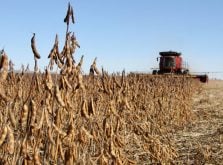Reports of more cattle in the Riding Mountain area of Manitoba testing positive or suspicious for bovine tuberculosis need to be taken with a grain of salt.
The Canadian Food Inspection Agency is evaluating a new blood test in the area that appears to be more sensitive than the traditional TB skin test.
Although about two dozen cattle have been identified as positive or suspicious under the newer test, there was no final confirmation as of Dec. 1 that any of those animals were infected with bovine TB.
Read Also

Manitoba extends Crown land rent freeze
Manitoba government links the continued rental rate freeze on grazing and forage leases to economic and environmental challenges facing the industry
It will be months before an evaluation of the blood test method is completed, said Brian Manns, a CFIA district veterinarian. There appears to be a greater level of sensitivity with that test, meaning it might raise red flags even when something other than bovine TB is present or when an animal has been exposed to but not fully infected by the disease.
The commercial name for the blood test is Bovigam. When an animal is identified as positive by that test, the herd will be placed in quarantine until the suspect animal is slaughtered and no visual signs of the disease are found.
As of Dec. 1, 18 cattle in the Riding Mountain area showed a positive reaction with the blood test. Another six were listed as suspicious, Manns said.
Where the tests shows suspicion that an animal is infected with TB, the owner has the option of having that animal slaughtered for further testing or waiting 25-30 days to have it retested.
However, if there is a herd where the blood test indicates a positive animal and a suspicious animal, both will be taken for slaughter and tested further, said Manns.
Although the blood test under evaluation is not yet officially recognized in Canada as a tool for detecting TB in cattle, it is being used in the United States and Australia.
Blaine Thompson, a CFIA veterinary program specialist, knows the trials of the blood test in the Riding Mountain area are adding worry for producers there. However, he hopes there will be benefits once the evaluation is done, including the possibility that the test could detect an infection far earlier than the traditional skin test.
“What we’re doing is test driving this test.”
Betty Green, president of the Manitoba Cattle Producers Association, said a delicate balance exists between the need for effective testing and the need to limit the burden on producers. Her association continues lobbying government for compensation to producers who present their animals for testing.
She hopes the numerous measures being taken to eradicate bovine TB in the Riding Mountain area will one day benefit producers. Although cases of the disease have been found only occasionally in cattle there in recent years, those were enough to cost Manitoba its TB-free status by U.S. standards.
“It’s critical that we deal with it today,” Green said. “The longer you leave it, the more potential there is for it to spread and become a more serious problem.”
Wild elk were considered a source of infection in the Riding Mountain National Park area. Green said good progress is being made by Manitoba Conservation and Parks Canada to cull the elk herd and to monitor more closely for bovine TB in wildlife.
Meanwhile, Manns said two cattle herds in the Riding Mountain area were placed under quarantine this fall due to initial suspicions raised by the traditional skin test.
Final confirmation had not been received as of Dec. 1.














